
The Napoleonic Wars (1803–1815) were a series of major global conflicts pitting the French Empire and its allies, led by Napoleon I, against a fluctuating array of European states formed into various coalitions. It produced a period of French domination over most of continental Europe. The wars stemmed from the unresolved disputes associated with the French Revolution and the French Revolutionary Wars consisting of the War of the First Coalition (1792–1797) and the War of the Second Coalition (1798–1802). The Napoleonic Wars are often described as five conflicts, each termed after the coalition that fought Napoleon: the Third Coalition (1803–1806), the Fourth (1806–1807), the Fifth (1809), the Sixth (1813–1814), and the Seventh (1815) plus the Peninsular War (1807–1814) and the French invasion of Russia (1812).
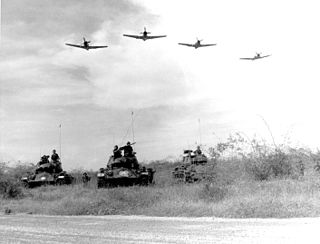
Combined arms is an approach to warfare that seeks to integrate different combat arms of a military to achieve mutually complementary effects. According to the strategist William S. Lind, combined arms can be distinguished from the concept of "supporting arms" as follows:
Combined arms hits the enemy with two or more arms simultaneously in such a manner that the actions he must take to defend himself from one make him more vulnerable to another. In contrast, supporting arms is hitting the enemy with two or more arms in sequence, or if simultaneously, then in such combination that the actions the enemy must take to defend himself from one also defends himself from the other(s).
Military strategy is a set of ideas implemented by military organizations to pursue desired strategic goals. Derived from the Greek word strategos, the term strategy, when it appeared in use during the 18th century, was seen in its narrow sense as the "art of the general", or "'the art of arrangement" of troops. Military strategy deals with the planning and conduct of campaigns, the movement and disposition of forces, and the deception of the enemy.

The Battle of Austerlitz, also known as the Battle of the Three Emperors, was one of the most important and decisive engagements of the Napoleonic Wars. The battle occurred near the town of Austerlitz in the Austrian Empire. The decisive victory of Napoleon's Grande Armée at Austerlitz brought the War of the Third Coalition to a rapid end, with the Treaty of Pressburg signed by the Austrians later in the month. The battle is often cited as a tactical masterpiece, in the same league as other historic engagements like Cannae or Gaugamela.

The Battle of Leipzig ; Swedish: Slaget vid Leipzig), also known as the Battle of the Nations, was fought from 16 to 19 October 1813 at Leipzig, Saxony. The Coalition armies of Austria, Prussia, Sweden, and Russia, led by Tsar Alexander I and Karl von Schwarzenberg, decisively defeated the Grande Armée of French Emperor Napoleon Bonaparte. Napoleon's army also contained Polish and Italian troops, as well as Germans from the Confederation of the Rhine. The battle was the culmination of the German Campaign of 1813 and involved 560,000 soldiers, 2,200 artillery pieces, the expenditure of 400,000 rounds of artillery ammunition, and 133,000 casualties, making it the largest battle in Europe prior to World War I.
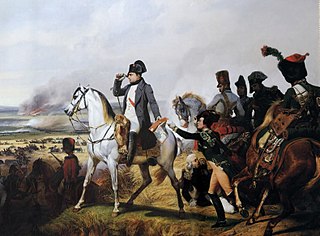
The Battle of Wagram was a military engagement of the Napoleonic Wars that ended in a costly but decisive victory for Emperor Napoleon's French and allied army against the Austrian army under the command of Archduke Charles of Austria-Teschen. The battle led to the breakup of the Fifth Coalition, the Austrian and British-led alliance against France. Wagram was the largest battle in European history up to its time.
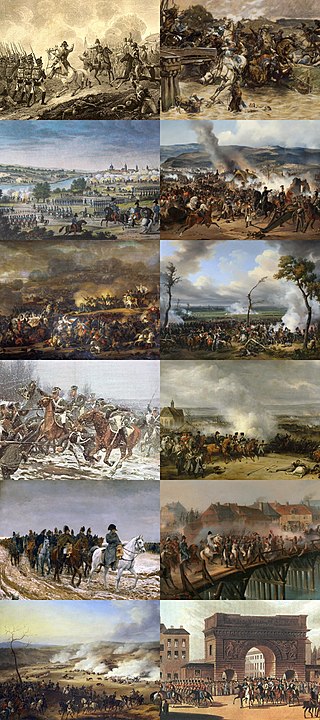
In the War of the Sixth Coalition, sometimes known in Germany as the Wars of Liberation, a coalition of Austria, Prussia, Russia, Spain, the United Kingdom, Portugal, Sweden, and a number of German States defeated France and drove Napoleon into exile on Elba. After the disastrous French invasion of Russia of 1812 in which they had been forced to support France, Prussia and Austria joined Russia, the United Kingdom, Sweden, and Portugal, and the rebels in Spain who were already at war with France.
Maneuver warfare, or manoeuvre warfare, is a military strategy which seeks to shatter the enemy's overall cohesion and will to fight.

The Six Days Campaign was a final series of victories by the forces of Napoleon I of France as the Sixth Coalition closed in on Paris.
Annihilation is a military strategy in which an attacking army seeks to entirely destroy the military capacity of the opposing army. This strategy can be executed in a single planned pivotal battle, called a "battle of annihilation". A successful battle of annihilation is accomplished through the use of tactical surprise, application of overwhelming force at a key point, or other tactics performed immediately before or during the battle.

The Battle of Stockach occurred on 25 March 1799, when French and Austrian armies fought for control of the geographically strategic Hegau region in present-day Baden-Württemberg. In the broader military context, this battle constitutes a keystone in the first campaign in southwestern Germany during the Wars of the Second Coalition, part of the French Revolutionary Wars.
The strategy of the central position was a key tactical doctrine followed by Napoleon in the Napoleonic Wars. It involved attacking two cooperating armies at their hinge, swinging around to fight one until it fled, then turning to face the other. The strategy allowed the use of a smaller force to defeat a larger one. However, these tactics, while successful at the battles of Ligny and Quatre Bras, failed at the Battle of Waterloo, and Napoleon was defeated because he was not able to prevent the joining of the British and Dutch forces by the Prussian forces.
Napoleon I, Emperor of the French, is recognized as one of the greatest commanders in military history. His main strategy was focusing on one part of the enemy, quickly defeating them, and continuing onward. His success was made possible not only by his ambition, but also through the dynamic composition of his army. Napoleon would see his equipment being gained through provisional control of the armories of France, thus allowing the weapons direct control by government
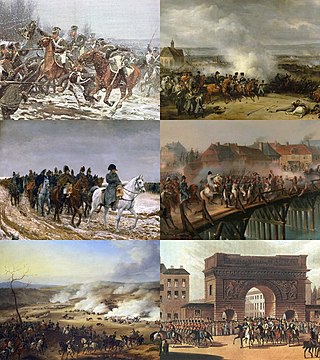
The 1814 campaign in north-east France was Napoleon's final campaign of the War of the Sixth Coalition. Following their victory at Leipzig in 1813, the Austrian, Prussian, Russian, and other German armies of the Sixth Coalition invaded France. Despite the disproportionate forces in favour of the Coalition, Napoleon managed to inflict some defeats, especially during the Six Days' Campaign. However, the campaign ended in total defeat for Napoleon as the Coalition kept advancing towards Paris as Napoleon was out of position to defend the capital, which capitulated in late March 1814. When Napoleon proposed the army march on Paris, his Marshals decided to unanimously overrule Napoleon in order to save the city from further destruction. As a result, the victorious Coalition negotiated the Treaty of Paris, under which Napoleon was exiled to the island of Elba and the borders of France were returned to where they had been in 1792.

The Battle of Theiningen was a battle in Germany fought on 22–23 August 1796 during the War of the First Coalition in which a French division, led by Jean-Baptiste Bernadotte, repulsed an attempted encirclement, and fought a successful rearguard action, despite being outnumbered three-to-one, against an Austrian army led by Archduke Charles of Austria, allowing the French Army of Sambre and Meuse to retreat toward the Rhine.

The Battle of Ostrach, also called the Battle by Ostrach, occurred on 20–21 March 1799. It was the first non-Italy-based battle of the War of the Second Coalition. The battle resulted in the victory of the Austrian forces, under the command of Archduke Charles, over the French forces, commanded by Jean-Baptiste Jourdan.
Defence in depth is a military strategy that seeks to delay rather than prevent the advance of an attacker, buying time and causing additional casualties by yielding space. Rather than defeating an attacker with a single, strong defensive line, defence in depth relies on the tendency of an attack to lose momentum over time or as it covers a larger area. A defender can thus yield lightly defended territory in an effort to stress an attacker's logistics or spread out a numerically superior attacking force. Once an attacker has lost momentum or is forced to spread out to pacify a large area, defensive counter-attacks can be mounted on the attacker's weak points, with the goal being to cause attrition or drive the attacker back to its original starting position.
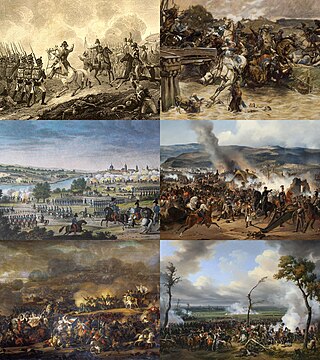
The German campaign was fought in 1813. Members of the Sixth Coalition, including the German states of Austria and Prussia, plus Russia and Sweden, fought a series of battles in Germany against the French Emperor Napoleon, his marshals, and the armies of the Confederation of the Rhine - an alliance of most of the other German states - which ended the domination of the First French Empire.
In military tactics, a flanking maneuver, or flanking manoeuvre, is an attack on the sides of an opposing force. If a flanking maneuver succeeds, the opposing force would be surrounded from two or more directions, which significantly reduces the maneuverability of the outflanked force and its ability to defend itself.













